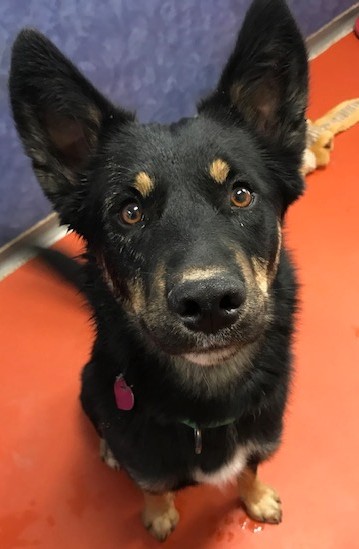
23 Aug Second Chance: Play it Safe!
Second Chance Humane Society’s Animal Resource Center and Thrift Shops have been serving San Miguel, Ouray & Montrose Counties for 27 years. Call 626-2273 to report a lost pet, learn about adopting a homeless pet, or about our Emergency Response, Community Medical, Spay/Neuter, Volunteer, or other services. View shelter pets and services online: www.adoptmountainpets.org.
Go here for more options from Second Chance.

Hey there, I’m Bandit, and I’m a “game on” kind of pup! I enjoy playing with dogs who are up for serious playtime. As a dog parent you should know there’s more than one way for dogs to play.
Let me explain…
Not all dogs enjoy playing with dogs. Many dog owners feel like there is an unwritten rule that all dogs should love playing with others, and theirs is a lemon if they don’t. Not true! And it’s normal for many dogs to become less interested in playing with others as they grow older.
For those who are playful – some dog play behavior is easy to spot, other times it’s tough. During canine play, dogs sometimes can act quite ferocious, including growling showing teeth, and rough physical interaction.
With dogs having a good time, play is a wonderful energy outlet as well as a way for dogs to keep up their “dogspeak” skills.
But there are some risks.
Different dogs play differently. Breed is a factor in how dogs enjoy playing. Some dogs are rough contact players. Others adore chase games. Keep in mind that not all play styles mesh well.
Not sure if a dog is having a good time? Hold back the “aggressor” of the two for a moment. If the “victim” comes over and wants to engage, then the “victim” was likely having a good time! If instead, the “victim” avoids the “aggressor”, they weren’t having fun, and playtime should be over.
For life-threatening danger, one dog getting their jaw caught in another dog’s collar tops the list. If that happens, both dogs usually panic – one can be choked and the other break their jaw. Dogs can and have lost their lives this way. Removing collars will eliminate this risk; if collars are on, close supervision means you can intervene immediately.
Another risk is size differential. When large dogs play with small dogs, no matter how well they play, there is always the risk of a smaller dog getting hurt accidentally. In addition, the high pitched noises of a small dog while being chased can kick in a predatory instinct in other dog(s); the ensuing pursuit can lead to unwanted results.
Another risk is a dog fight. While there are many triggers for fighting, over-arousal is a big one. Healthy play between dogs typically involves short breaks to catch their breath and a pause before starting up again. If dogs do not take breaks on their own, we should intervene before trouble starts. Interrupt play frequently to prevent dogs from tipping over into arguments, which happens when pups are really aroused.
Other inappropriate dynamics include bullying, mounting, and stalking. These too can be prevented with supervision and intervention. Recognizing canine “stress signs” means you can see when one dog is feeling overwhelmed and needs a break before the dog feels the need to escalate for defense.
About me.
I am a young shepherd mix who is very energetic. Fortunately I have multiple dog friends here at the shelter to help me work off my energy while waiting for my forever family to come adopt me. I also love to play in the water and go on adventures! I am seeking an active family with time to work on my training. Come meet me today!


Sorry, the comment form is closed at this time.